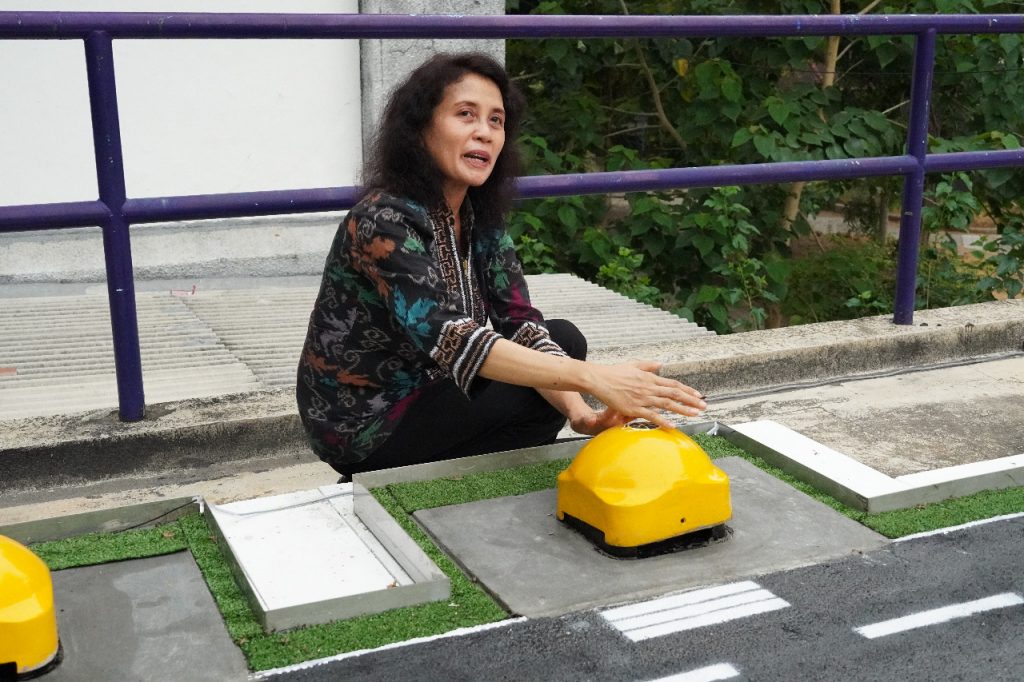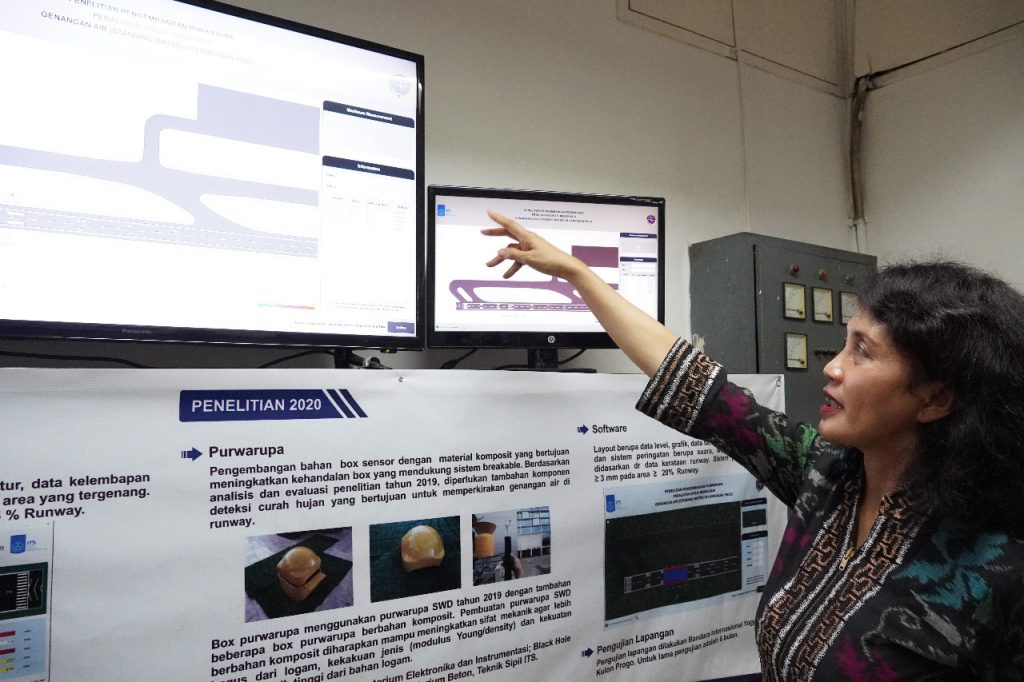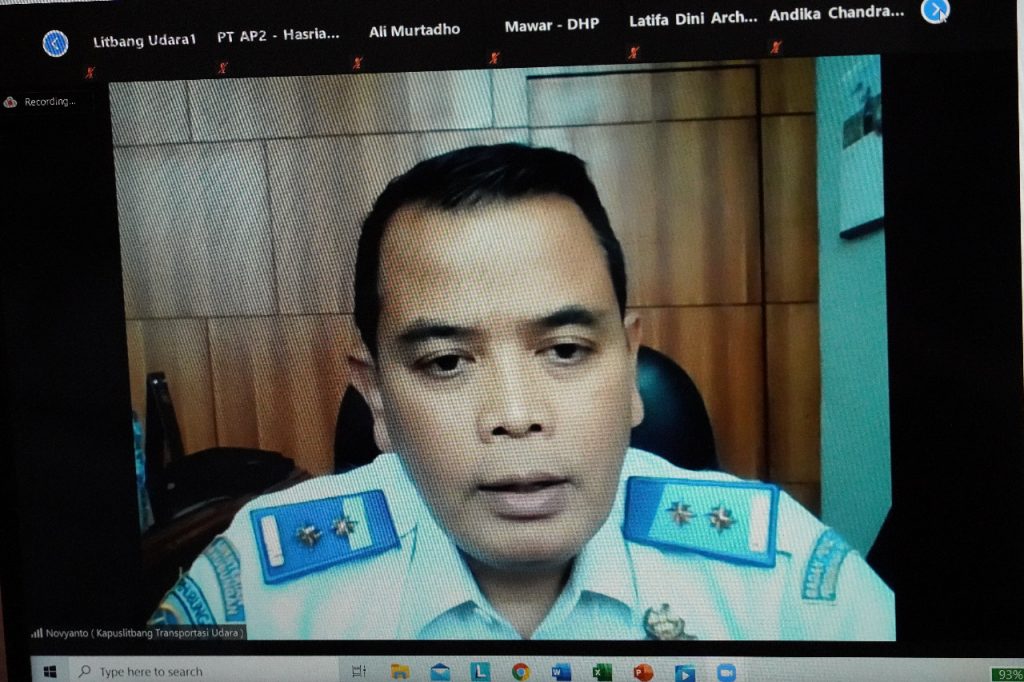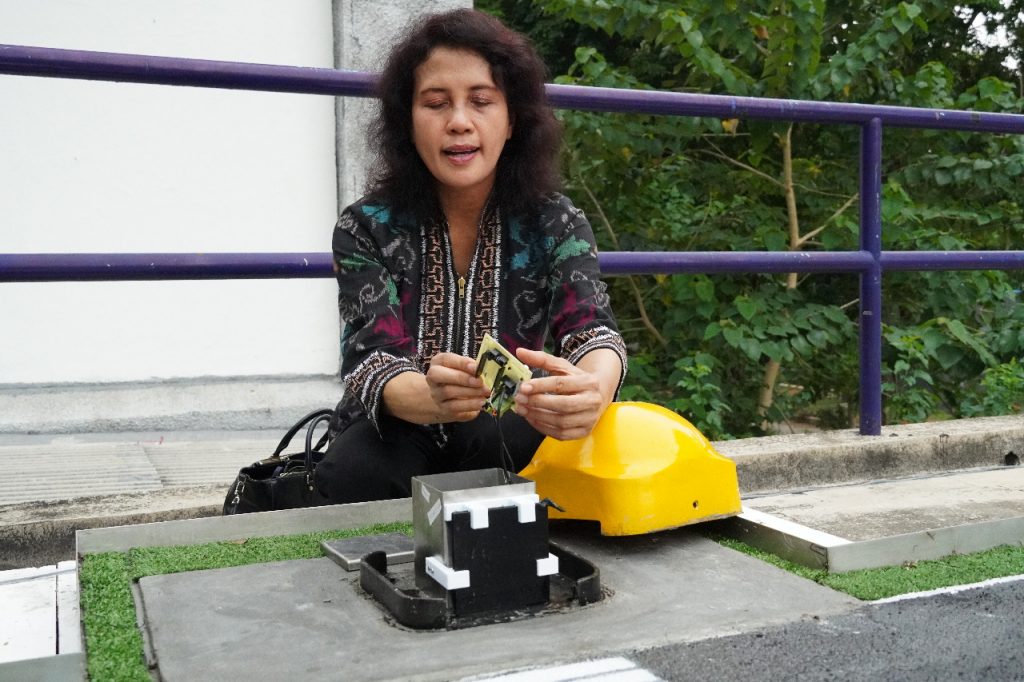ITS – Puslitbang TU Keeps Developing Water Puddle Detector in Runway

Dr. Melania Suweni Muntini explains and shows the components of the Standing Water Detector device designed by her team on the prototype runway at the airport.
ITS Campus, ITS News – Sepuluh Nopember Institute of Technology (ITS) together with the Research and Development Center for Air Transportation (Puslitbang TU) Balitbang Ministry of Transportation continues to strive to develop the results of their research in the form of a Standing Water Detector (SWD) or a device for detecting high standing water on the runway airport (airport). The reliability of the research that has been carried out since 2018 was discussed in an online Focus Group Discussion (FGD), Thursday (26/11).
As is known, the high rainfall in several regions in Indonesia has triggered a puddle of water on the runway or runway at the airport, thus threatening the safety of planes that will land. Therefore, this research was conducted to support the development of aviation safety equipment.
The Head Researcher of SWD, Dr. Melania Suweni Muntini MT, explained that the main problem in aviation is that airplane pilots often do not get real-time information about standing water on the runway. “With this tool, we will get information about the height of the standing water on the runway so that the information can be used for various purposes,” she explained.
For the next six months, continued the lecturer, who is familiarly called Melani now; the development started in 2018 is focused on the reliability test of SWD with tests carried out directly at Yogyakarta International Airport (YIA). This year, sensors were added to measure the real-time rainfall. “Measurement of rainfall will work in conjunction with measuring water levels,” she said.

Dr. Melania Suweni Muntini explains how the Standing Water Detector tool works, which is reported via a monitor at the Instrumentation and Electronics Laboratory, ITS Physics Department.
Apart from the airport, testing was also carried out at the ITS Physics Department’s open laboratory to ensure that the equipment worked properly in both places. “Another reason is that when it rains at the airport, we cannot see the equipment directly because it is dangerous. “In the lab, we can calibrate directly after data acquisition,” said Melani.
This tool has two detection systems, namely hardware, and software. For software, data such as the runway profile in the form of roughness and the runway slope. The hardware itself will be able to detect air temperature and humidity. “For the standing water detection method, we refer to the Regulation of the Director-General of Civil Aviation No. KP 39/2015 and Annex 14, Aerodrome, ”explained the ITS Physics Department lecturer.
In operation, the SWD prototype will be placed beside the runway in the touchdown area. When it rains, the water flow from the runway will touch the prototype’s sensors, which will then be converted into digital data. Then combined with secondary data such as runway profiles, it will provide output in the form of standing water heights. A reminder will flash when 25 percent of the instrument indicates that the altitude is equal to or greater than 3 millimeters.
This time, the reliability test phase is interspersed with certification from the SWD itself. Certification will require procedures and participation from various parties in the aviation sector—the Head of the Air Transportation Research and Development Center, Capt. Novyanto Widadi SAP MM also said that the certification stage would be considered in terms of regulations by the Ministry of Transportation. “After these stages are completed, this tool will certainly be able to be used en masse at various airports in Indonesia,” she said.

Head of Research and Development Center for Air Transportation Balitbang Kemenhub Capt Novyanto Widadi SAP MM
Certification of this tool is necessary considering a large number of airports in Indonesia. Head of the Main Class I Airport Authority Office, Ir Mohammad Alwi MM revealed, the more uncertain the rainfall, this tool is very suitable for Indonesia. “If this tool has been certified, we don’t need to hesitate anymore to use this tool,” she said.
Positive responses were received from various parties involved in the world of aviation. General Manager of AirNav Surabaya Branch, MT Nurhuda, conveyed that communicating to pilots who will make direct landings regarding standing water is crucial to make the right decisions on landing. “This certainly can reduce the time the aircraft is holding in the air, and also reduce the pressure on the air traffic controller,” she said.
Nurhuda also hopes that the prototype can be applied at Juanda Airport, Surabaya, and other airports in Indonesia. Given the climate and rain has started to be difficult to predict, even in Surabaya itself. “At Juanda, there is often standing water. However, it seems that it is still tolerable so far, but we want to know for sure whether this is safe or not, “she said. (ri/nadh/ITS Public Relations)

Dr. Melania Suweni Muntini explains and shows the components of the Standing Water Detector device designed by her team on the prototype runway at the airport.
Related News
-
ITS Collaboration with BPBD East Java, Launching VR Disaster Simulation
ITS Campus, ITS News — Supporting anticipation of disasters and continuing to educate the public, Institut Teknologi Sepuluh Nopember
November 27, 2020 07:11 -
Supporting the Implementation of Innovative Ideas, ITS and IYSA Hold International Competition
ITS Campus, ITS News — Institut Teknologi Sepuluh Nopember (ITS) has once again proven its commitment to supporting the
November 27, 2020 07:11 -
ITS Maintains Informative Qualification for Five Consecutive Years at KIP Awards
ITS Campus, ITS News — Institut Teknologi Sepuluh Nopember (ITS) has once again successfully maintained its Informative Qualification predicate
November 27, 2020 07:11 -
ITS Strengthens Smart Eco-Campus through UI GreenMetric 2024
ITS Campus, ITS News — Institut Teknologi Sepuluh Nopember (ITS) has once again demonstrated its commitment to environmental concern
November 27, 2020 07:11
